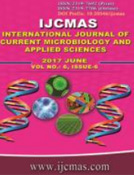


 National Academy of Agricultural Sciences (NAAS)
National Academy of Agricultural Sciences (NAAS)

|
PRINT ISSN : 2319-7692
Online ISSN : 2319-7706 Issues : 12 per year Publisher : Excellent Publishers Email : editorijcmas@gmail.com / submit@ijcmas.com Editor-in-chief: Dr.M.Prakash Index Copernicus ICV 2018: 95.39 NAAS RATING 2020: 5.38 |
The present study was conducted at experimental farm of CSK HPKV, Palampur, during the year 2012-2013 with the objectives of evaluating the effects of drip irrigation levels applied at CPE 0.4, 0.6 and 0.8 and different methods of fertilizer application on growth, quality parameters, productivity and nutrient uptake of broccoli. The treatments comprised of (a) three drip irrigation levels viz., I0.4 – Drip at 40 per cent CPE, I0.6 – Drip at 60 per cent CPE and I0.8 – Drip at 80 per cent CPE (b) three fertilizer application levels viz., F100–100 per cent recommended dose of fertilizer through fertigation, FC25+F75 – 25 percent recommended dose of fertilizer through conventional method as a basal dose and 75 per cent through fertigation and FCF –100 per cent of recommended dose of fertilizer through conventional method and fertilizers, (c) control - Flood irrigation of 4 cm at 8-10 days interval + 100 per cent recommended dose of fertilizer and (d) absolute control- No recommended dose of fertilizer and flood irrigation of 4 cm at 8-10 days interval. The broccoli cv. Palam Samridhi was transplanted on October 31, 2012. The results indicated that I0.8 and IRec treatment had higher soil water content in comparison to I0.4 and I0.6. The I0.8 treatment due to favorable soil moisture regimes led to better marketable curd yield, TSS, ascorbic acid, chlorophyll content, NPK uptake, fertilizer use efficiency w.r.t N, P and K, fertilizer expense efficiency in comparison to I0.4, I0.6 and IRec. Likewise, F100 and FC25+F75 treatment had higher marketable curd yield, TSS, ascorbic acid, chlorophyll content, NPK uptake in comparison to FCF. The marketable curd yield obtained under I0.4F100 was at par with I0.6F100 treatment, which resulted in saving of 20 per cent irrigation water.
 |
 |
 |
 |
 |